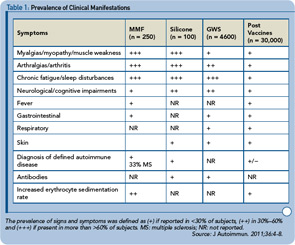Infectious agents are probably the environmental factors most closely associated with autoimmunity and autoimmune diseases.9 Recently, Rose proposed that, in addition to the known mechanisms by which infections elicit autoimmunity, an infectious adjuvant mechanism may play a role in immunopathogenesis.18 For instance, complete Freund’s adjuvant is a water-and-oil emulsion that includes killed mycobacterium. This adjuvant has been used to induce autoimmune diseases in many experimental models.18 Another example of the role of material for infectious organisms in eliciting autoimmunity is the requirement of the microbial component lipopoplysaccharide, used as an adjuvant, in certain disease models. The administration of lipopoplysaccharide with coxsackievirus B3 is used to overcome a genetic barrier and induce autoimmune myocarditis in a strain of mice genetically resistant to infection with coxsackievirus alone.18
Despite their ability to boost immune responses, in the past, adjuvants were generally considered to be inert materials that posed little or no independent threat to the host. Alas, animal studies as well as reports of human diseases have clearly demonstrated the ability of adjuvants to inflict diseases by themselves.
From these observations, it appears that the activation of the immune system by natural adjuvants (e.g., infectious agents) or pharmaceutical ones (e.g., vaccines containing alum or silicone), while usually followed by a desired activation of the immune system, could, in certain situations, trigger manifestations of autoimmunity or even autoimmune diseases itself.3,10 Yet the appearance of these diseases in association with exposure to an adjuvant is not as widespread as could be expected. This inconsistency may depend on the adjuvant itself, the genetic susceptibility of the exposed individual, and the rate of diagnosis and reporting such plausible associations.
Siliconosis: An Adjuvant Disease
Silicone-induced autoimmune phenomena was termed in the early 1990s, “the adjuvant disease.”2 At that time, various case reports of defined connective tissue diseases as well as a large cohort study, based on self-reported symptoms, suggested an association between silicone implants and defined connective tissue diseases.19 This association was later disputed by Janowsky et al in a meta-analysis performed that did not include the former study.20
Unlike the controversy regarding defined autoimmune diseases, a relationship between silicone implants and a constellation of signs and symptoms that do not fulfill a specific diagnosis was established several years later. In 2003, Vasey et al reported a statistically significant increase in body aches, joint pain, myalgia, fatigue, impaired cognition, and other symptoms following exposure to silicone.21 These findings were supported by another large study that reported an increase in similar symptoms among patients with silicone breast implants compared with a group of women who underwent reduction mammoplasties.2 The reported manifestations in both studies bear a resemblance to fibromyalgia and chronic fatigue syndrome. This was even further strengthened by the U.S. Food and Drug Administration’s finding that there is a correlation between fibromyalgia and ruptured silicone gel implants.2
Vaccines and Adjuvant Disease
Vaccines have been safely and effectively administered to humans and animals worldwide for 200 years, thereby enabling the elimination of many serious and life-threatening infectious diseases. Nevertheless, postvaccination adverse events, mostly transient and self-limited ones, have been reported. In addition, the occurrence of autoantibodies, inflammation, arthritis, neuronal damage, fatigue, cognitive impairment, and even overt autoimmune disease have been rarely observed among immunized people.3

